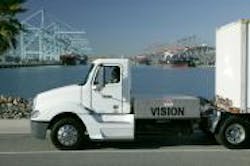“Our commitment to working with companies that develop zero-emission trucks is another important strategy in our plan to grow Los Angeles green by being a catalyst in testing and bringing to market the most promising emission reduction technologies.” –Antonio Villaraigosa, Mayor, Los Angeles
So the port of Los Angeles is in the midst of testing a new kind of “green” truck, if you will: a fuel cell-electric hybrid drayage tractor designed for short and medium distance cargo-hauling operations.
This tractor prototype, retrofitted by Vision Industries of Los Angeles, is being put through a series of on-road and laboratory tests to mimic a variety of drayage duty cycles, including different loads, road conditions and travel distances.
The port says local drayage trucking companies are expected to assist with the demonstration over the next 12 to 18 months, with the University of California at Riverside’s college of engineering center for environmental research and technology (CE-CERT) laboratories will help guide the data collection and analysis.
[Here’s a video walk-around of this new hybrid tractor, courtesy of Los Angeles' port authority.]
The powertrain for this tractor, as noted, is very from what’s typically brought to mind by the word “hybrid.” Instead of a diesel engine linked to an electric motor and battery pack, Vision’s hybrid trucks are powered by the combination of a hydrogen fuel cell, electric motor, and lithium batteries -- with a purported range of up to 400 miles. In essence, the truck runs on hydrogen, which emits nothing more than water vapor out the tail pipe. Frankly, you can’t get much cleaner than that.
The key, however, is sustainability – from an economic standpoint, I stress. Hydrogen fuel cells to power vehicles don’t come cheap. It’s been rumored that the value of Honda’s FCX Clarity fuel cell passenger cars, for example, is about $10 million a copy – a price tag that incorporates the millions in research Honda has spent developing a fuel cell-powered vehicle. Indeed, Honda’s been researching fuel cells since 1989, but only released a prototype vehicle back in 2003 powered by this technology.
[Here’s an overview of the 2009 model Honda FCX Clarity – the only production-level fuel cell vehicle to my knowledge.]
Obviously, with water vapor as the only emission from such a vehicle, it garners a lot of interest from a lot of different areas. Indeed, Honda is taking the next step in making fuel cells more convenient for the average motorist with the testing of a solar hydrogen generation station prototype (appropriately located in Los Angeles, the home of Honda R&D Americas Inc.'s main reserach center) intended for ultimate use as a home refueling appliance capable of an overnight refill of fuel cell electric vehicles.
Designed as a single, integrated unit to fit in the user's garage, Honda said its next generation solar hydrogen station reduces the size of the system, while producing enough hydrogen (0.5 kg) via an 8-hour overnight fill for daily commuting (10,000 miles per year) for a fuel cell electric vehicle.
Compatible with a "Smart Grid" energy system, Honda said its solar hydrogen station would enable users to refill their vehicle overnight without the requirement of hydrogen storage, which would lower carbon dioxide (CO2) emissions by using less expensive off-peak electrical power. During daytime peak power times, the solar hydrogen station can export renewable electricity to the grid, providing a cost benefit to the customer, while remaining energy neutral.
You can see why this innovation would convince fleet operators to perhaps look more closely at fuel cells for trucks – for if you could build a solar-powered hydrogen generating system at a terminal with enough capacity to refuel your trucks overnight, presto! Kiss OPEC and local diesel filling station goodbye.
But as the old British seafaring song says, “It’s a long way to Tipperary.” These are but the very first baby steps on a very long road to making fuel cells sustainable from an economic perspective for fleets. For starters, while solar power generation looks good on paper, but as we all know, the sun doesn’t shine 24/7 across the U.S.
Indeed, on the trucking side, Vision Industries has been marketing its Class 8 zero-emission hydrogen fuel cell hybrid-electric truck for more than a year and is just now getting to work with the port of Los Angeles to further evaluate its performance in the rigorous port trucking environment.
Though Martin Schuermann, Vision’s president and CEO, noted that these fuel cell hybrid tractors are 30% to 40% less expensive to operate than diesel trucks, the sticker price is a different story – as is the lack of convenient refueling infrastructure. In time, these obstacles can be overcome, but at the end of the day, fuel cell-powered commercial vehicles can’t just be “green” trucks from an environmental perspective alone – they have to economically “green” as well to convince fleets to try them, buy them, and then keep them for the long haul.
